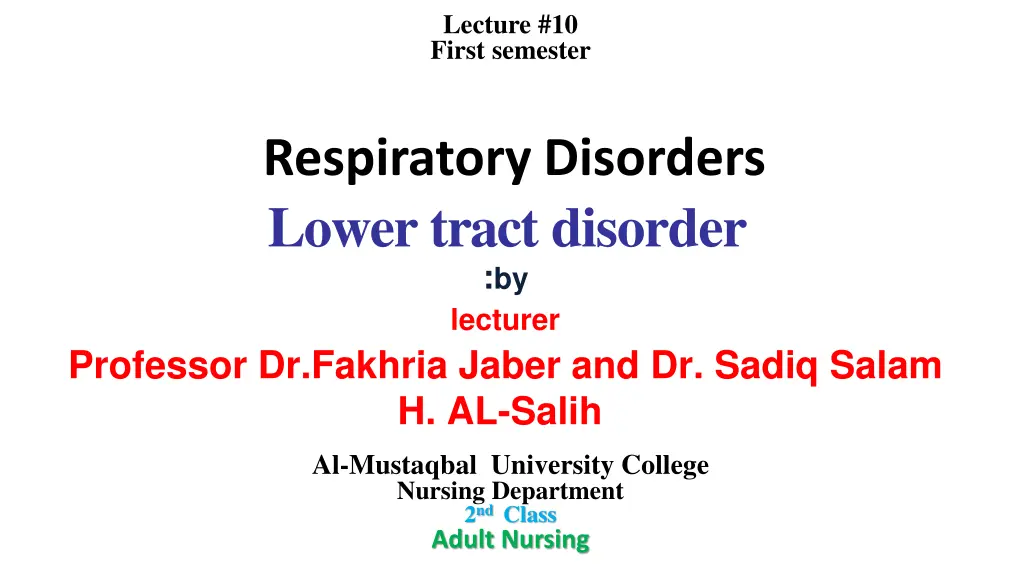
Respiratory Disorders: Lower Tract Disorders Overview
Explore respiratory disorders of the lower tract including acute tracheobronchitis and pneumonia. Learn about their clinical manifestations, medical management, categories, and risk factors. Enhance your knowledge in adult nursing with this comprehensive lecture.
Download Presentation

Please find below an Image/Link to download the presentation.
The content on the website is provided AS IS for your information and personal use only. It may not be sold, licensed, or shared on other websites without obtaining consent from the author. If you encounter any issues during the download, it is possible that the publisher has removed the file from their server.
You are allowed to download the files provided on this website for personal or commercial use, subject to the condition that they are used lawfully. All files are the property of their respective owners.
The content on the website is provided AS IS for your information and personal use only. It may not be sold, licensed, or shared on other websites without obtaining consent from the author.
E N D
Presentation Transcript
Lecture #10 First semester Respiratory Disorders Lower tract disorder :by lecturer Professor Dr.Fakhria Jaber and Dr. Sadiq Salam H. AL-Salih Al-Mustaqbal University College Nursing Department 2nd Class Adult Nursing
Respiratory infections // Acute Tracheobronchitis // Acute tracheobronchitis, an acute inflammation of the mucous membranes of the trachea and the bronchial tree, often follows infection of the upper respiratory tract. A patient with a viral infection has decreased resistance and can readily develop a secondary bacterial infection. Thus, adequate treatment of upper respiratory tract infection is one of the major factors in the prevention of acute bronchitis. Inhalation of physical and chemical irritants, gases, and other air contaminants can also cause acute bronchial irritation.
Clinical Manifestations Initially, the patient has a dry, irritating cough and expectorates a scanty amount of mucoid sputum. The patient complains of sternal soreness from coughing and has fever or chills and night sweats, headache, malaise. As the infection progresses, the patient may be shortness of breath, have noisy inspiration and expiration (inspiratory stridor and expiratory wheeze) Medical management Antibiotictreatmentmay be indicateddepending onthe symptoms, sputum purulence, and results of sputum culture. Expectorants may be prescribed, Fluid intake is increased to thin the viscous secretions.
Pneumonia Pneumonia is an inflammation of the lung parenchyma that is caused by a microbial agent. Pneumonitis is a more general term that describes an inflammatory process in the lung tissue Pneumonia is the most common cause of death from infectious diseases in persons 65 years of age and older, Bacteriacommonly pneumonia in the presence of an intact host defense mechanism. enter the lower airway but do not cause When pneumonia does occur, it is caused by various microorganisms, including bacteria, mycobacteria, chlamydiae, mycoplasma, fungi, parasites, and viruses.
Category of pneumonias: Community-acquired pneumonia, Hospital acquired pneumonia, Pneumonia in the immuno-compromised host Aspiration pneumonia
Risk Factors for Pneumonia Conditions that produce mucus or bronchial obstruction and interfere with normal lung drainage (eg, cancer, cigarette smoking, COPD) Smoking;cigarettesmoke disruptsboth mucociliary macrophage activity and Depressed cough reflex (due to medications, a debilitated state, or weak respiratory muscles); aspiration of foreign material into the lungs during a period of unconsciousness Nothing-by-mouth orogastric, or endotracheal tube (NPO)status; placement of nasogastric,
Antibiotic therapy (in very ill people, the oropharynx is likely to be colonized by gram- negative bacteria) Immunosuppressed patients and those with a low neutrophils Prolonged immobility and shallow breathing pattern General anesthetic, sedative, or opioid preparations that promote respiratory depression, Advanced age, because of possible depressed cough and glottic reflexes and nutritional depletion. Respiratory therapy with improperly cleaned equipment Medical Management The treatment of pneumonia includes administration of the appropriate antibiotic as determined by the results of the Gram stain.
Chronic Obstructive Pulmonary Disease Chronic obstructive pulmonary disease (COPD) is a disease state characterized by airflow limitation that is not fully reversible. COPD may include diseases that cause airflow obstruction (eg, emphysema, chronic bronchitis) or a combination of these disorders. People with COPD commonly become symptomatic during the middle adult years, and the incidence of COPD increases with age. Although certain aspects of lung function normally decrease with age; COPD accentuates and accelerates these physiologic changes.
Chronic Bronchitis Chronic bronchitis, a disease of the airways, is defined as the presence of cough and sputum production for at least 3 months in each of 2 consecutive years. In many cases, smoke or other environmental pollutants irritate the airways, resulting in hypersecretionof mucus and inflammation. The bronchial walls become thickened, the bronchial lumen is narrowed, and mucus may plug the airway. Alveoli adjacent to the bronchioles may become damaged and fibrosed, resulting in altered function of the alveolar macrophages.
Emphysema Emphysema is a term that describes an abnormal distention of beyond the terminal destruction of the walls of the alveoli the air spaces bronchioles, with As the walls of the alveoli are destroyed (a process accelerated infections), the alveolar direct contact with capillaries continually decreases, causing an increase in dead space (lung area where no gas exchange can occur) impaired oxygen diffusion, which leads to hypoxemia. by recurrent surface area in the pulmonary and
Medical management Bronchodilators: beta-adrenergic agonists, anticholinergic agents, and methylxanthines. These medications may be used in combination to optimize the bronchodilation effect. Some of these medications are short-acting; others long-acting. Nebulized medications (nebulization of medication via an air compressor) may also be effective in patients who cannot use an MDI properly or who prefer this method of administration. Corticosteroids. Inhaled and systemic corticosteroids (oral or intravenous) may also be used in COPD but are used more frequently in asthma.Although it has been shown that corticosteroids do not slow the decline in lung function, these medications may improve symptoms.
PLAN OF NURSING CARE TO PATIENT WITH COPD Nursing Diagnosis: Impaired gas exchange and impaired airway clearance due to chronic inhalation of toxins Goal: Improvement in gas exchange 1- Evaluate current smoking status, educate regarding smoking cessation, and facilitate efforts to quit. 2- Evaluate current exposure to occupational toxins or pollutants and indoor/outdoor pollution. Nursing Diagnosis: Impaired gas exchange associated with ventilation perfusion inequality Goal: Improvement in gas exchange 1- Administer bronchodilators as prescribed. a. Inhalation is the preferred route. b. Observe for side effects: tachycardia, arrhythmias, central nervous system excitation, nausea, and vomiting. 2.Instruct and encourage patient in diaphragmatic breathing and effective coughing. 3. Administer oxygen by the method prescribed. Nursing Diagnosis: Impaired airway clearance associated with bronchoconstriction, increased mucus production, ineffective cough, bronchopulmonary infection, and other complications Goal: Achievement of airway clearance
Cont. 1- hydrate the patient. 2- Instruct in and encourage the use of diaphragmatic breathing and coughing techniques. 3- If indicated, perform postural drainage with percussion and vibration in the morning and at night as prescribed. 4-Instruct patient to avoid bronchial irritants such as cigarette smoke, aerosols, extremes of temperature, and fumes. 5- Educate about early signs of infection that are to be reported to the primary provider immediately: 6- Administer antibiotics as prescribed. Nursing Diagnosis: Activity intolerance due to fatigue, hypoxemia, and impaired breathing Goal: Improvement in activity tolerance 1- Support patient in establishing a regular regimen of exercise using treadmill and exercise bicycle, walking, or other appropriate exercises, such as mall walking. a. Assess the patient s current level of functioning, and develop exercise plan based on baseline functional status. b. Suggest consultation with a physical therapist or pulmonary rehabilitation program to determine an exercise program specific to the patient s capability. Have portable oxygen unit available if oxygen is prescribed for exercise.






















